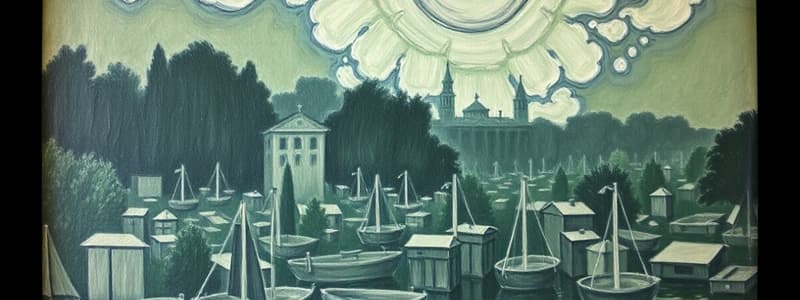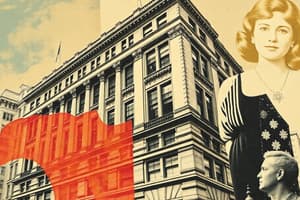Podcast
Questions and Answers
What action did banks take to address panic selling on the market?
What action did banks take to address panic selling on the market?
- They issued loans to investors.
- They stopped buying shares to prevent further panic. (correct)
- They increased interest rates on stock purchases.
- They bought more shares to stabilize prices.
Which event is referred to as 'Black Tuesday'?
Which event is referred to as 'Black Tuesday'?
- The day when heavy selling reached 9 million shares traded.
- The day with 16.4 million shares traded and no buyers present. (correct)
- The day when banks intervened and bought shares to calm the market.
- The day when 6 million shares were traded and some were still bought.
On what date did President Hoover make a speech declaring that the market was okay?
On what date did President Hoover make a speech declaring that the market was okay?
- October 26th (correct)
- October 25th
- October 28th
- October 29th
What was the primary reason for the stock prices to continue falling leading up to Black Thursday?
What was the primary reason for the stock prices to continue falling leading up to Black Thursday?
How many shares were traded on October 24th, known as Black Thursday?
How many shares were traded on October 24th, known as Black Thursday?
How did the wealth gap in the US contribute to the Wall Street Crash?
How did the wealth gap in the US contribute to the Wall Street Crash?
What was a result of overproduction by US industries in the late 1920s?
What was a result of overproduction by US industries in the late 1920s?
How did tariffs imposed by the Republican government affect American farmers?
How did tariffs imposed by the Republican government affect American farmers?
What was one of the consequences of the saturation of the market by the late 1920s?
What was one of the consequences of the saturation of the market by the late 1920s?
What impact did increased unemployment have on the economy during this period?
What impact did increased unemployment have on the economy during this period?
What caused many farmers to go bankrupt by 1929?
What caused many farmers to go bankrupt by 1929?
Which management technique contributed to overproduction in industries?
Which management technique contributed to overproduction in industries?
Why were American farmers unable to compete effectively in the global market during the late 1920s?
Why were American farmers unable to compete effectively in the global market during the late 1920s?
What was a primary reason US companies struggled to sell their products internationally in the 1920s?
What was a primary reason US companies struggled to sell their products internationally in the 1920s?
What does 'Buying on Margin' refer to?
What does 'Buying on Margin' refer to?
Why did speculators become nervous in the late 1920s?
Why did speculators become nervous in the late 1920s?
What event triggered the panic selling of shares in October 1929?
What event triggered the panic selling of shares in October 1929?
What was the consequence of the decision made by the top 6 banks on October 25?
What was the consequence of the decision made by the top 6 banks on October 25?
How did the public's reaction during the stock market crash affect banks?
How did the public's reaction during the stock market crash affect banks?
What impact did the decline in the construction and car industries have on the economy?
What impact did the decline in the construction and car industries have on the economy?
What was the outcome for many speculators when share prices fell?
What was the outcome for many speculators when share prices fell?
What major economic indicator showed a downturn in the late 1920s?
What major economic indicator showed a downturn in the late 1920s?
Which factor contributed to the panic in the stock market in October 1929?
Which factor contributed to the panic in the stock market in October 1929?
What percentage of their own money did speculators typically use when buying shares on margin?
What percentage of their own money did speculators typically use when buying shares on margin?
What was a common misconception among speculators during the 1920s regarding share prices?
What was a common misconception among speculators during the 1920s regarding share prices?
By what year had the number of share owners in the U.S. reached 20 million?
By what year had the number of share owners in the U.S. reached 20 million?
What effect did the banks' lending practices have on speculation?
What effect did the banks' lending practices have on speculation?
What realization led to the rapid selling of shares in the market during the crisis?
What realization led to the rapid selling of shares in the market during the crisis?
How did the increase in share price speculation contribute to the eventual market crash?
How did the increase in share price speculation contribute to the eventual market crash?
What was one significant issue faced by small rural banks in the USA during the 1920s?
What was one significant issue faced by small rural banks in the USA during the 1920s?
What economic policy did the Republican Party endorse during the 1920s?
What economic policy did the Republican Party endorse during the 1920s?
What event marked the beginning of panic selling on Wall Street in October 1929?
What event marked the beginning of panic selling on Wall Street in October 1929?
What was a key factor that encouraged speculation in the stock market from 1928 onward?
What was a key factor that encouraged speculation in the stock market from 1928 onward?
What occurred on October 26, 1929, that illustrated the government's reaction to the stock market turmoil?
What occurred on October 26, 1929, that illustrated the government's reaction to the stock market turmoil?
Which of the following conditions was evident in the US economy prior to the Wall Street Crash?
Which of the following conditions was evident in the US economy prior to the Wall Street Crash?
During the 1920s, approximately how many banks were operating in the USA?
During the 1920s, approximately how many banks were operating in the USA?
What triggered the Babson Break in September 1929?
What triggered the Babson Break in September 1929?
Flashcards
Wealth Gap
Wealth Gap
Uneven distribution of wealth, with a large portion of the population living in poverty. This meant fewer people could afford to buy goods, leading to overproduction and falling prices.
Overproduction
Overproduction
US industries and farmers produced more goods and crops than people could buy, leading to a surplus and falling prices.
Saturated Market
Saturated Market
When there are more goods available than consumers want or need, leading to falling prices and profits.
Assembly Line
Assembly Line
Signup and view all the flashcards
Taylorism
Taylorism
Signup and view all the flashcards
Tariffs
Tariffs
Signup and view all the flashcards
Hawley-Smoot Tariff
Hawley-Smoot Tariff
Signup and view all the flashcards
Why did farmers go bankrupt?
Why did farmers go bankrupt?
Signup and view all the flashcards
Speculation on the Stock Market
Speculation on the Stock Market
Signup and view all the flashcards
Buying on Margin
Buying on Margin
Signup and view all the flashcards
What happened in October 1929?
What happened in October 1929?
Signup and view all the flashcards
Impact of Stock Market Crash on Speculators
Impact of Stock Market Crash on Speculators
Signup and view all the flashcards
Role of Banks in Speculation
Role of Banks in Speculation
Signup and view all the flashcards
Signs of a Weakening Economy
Signs of a Weakening Economy
Signup and view all the flashcards
Confidence in the Stock Market
Confidence in the Stock Market
Signup and view all the flashcards
Impact of Speculation on the Economy
Impact of Speculation on the Economy
Signup and view all the flashcards
Laissez-faire economics
Laissez-faire economics
Signup and view all the flashcards
Liquidity in banking
Liquidity in banking
Signup and view all the flashcards
What caused the decline in farming in the 1920s?
What caused the decline in farming in the 1920s?
Signup and view all the flashcards
Signs of economic slowdown in 1929
Signs of economic slowdown in 1929
Signup and view all the flashcards
The Babson Break
The Babson Break
Signup and view all the flashcards
Black Thursday
Black Thursday
Signup and view all the flashcards
October 25th Intervention
October 25th Intervention
Signup and view all the flashcards
Panic Selling
Panic Selling
Signup and view all the flashcards
Speculation
Speculation
Signup and view all the flashcards
Impact of Banks on Speculation
Impact of Banks on Speculation
Signup and view all the flashcards
How Did the Stock Market Crash Impact Banks?
How Did the Stock Market Crash Impact Banks?
Signup and view all the flashcards
What Role Did the 6 Major Banks Play in the Crash?
What Role Did the 6 Major Banks Play in the Crash?
Signup and view all the flashcards
What were the early signs of a weakening economy?
What were the early signs of a weakening economy?
Signup and view all the flashcards
Why did speculators get nervous?
Why did speculators get nervous?
Signup and view all the flashcards
What caused the panic on October 29th?
What caused the panic on October 29th?
Signup and view all the flashcards
Study Notes
Underlying Economic Weaknesses of the 1920s
- Wealth gap: In 1925, 42% of the population had incomes below the poverty line, lacking sufficient funds to purchase necessities.
- Unsaturated market: Consumer goods became readily available, creating an oversupply, leading to reduced company sales, profits, and stock prices.
- Overproduction in industry: Mass production and new management techniques increased output dramatically, exceeding consumer demand in the late 1920s.
- Agricultural overproduction: Farmers used new technologies, resulting in surplus crops. They faced reduced ability to sell their produce due to international tariffs, causing significant economic hardship.
- Reduced export markets: Tariffs imposed by other countries limited US exports, resulting in a decrease in sales and profit for US companies.
Speculation in the Stock Market
- Speculators: Individuals buying shares with borrowed money (margin), hoping for price increases and quick profits.
- Buying on margin: Investors borrowing 90% of a share's cost.
- Economic downturn: As the economy slowed in the late 1920s, speculators became nervous and began to sell their shares.
- Panic selling: The prospect of lower share prices triggered widespread panic selling, causing a rapid and drastic drop in share prices.
- Bank failures: Many speculators were unable to repay their loans, pushing banks to failure. This resulted in insufficient liquidity to cover depositors' needs.
- 6 Major Banks: On October 25th , 6 major banks met to attempt to prevent further declines in the market. Unfortunately, this action proved unsuccessful and further exacerbated the problems.
Role of the Banking System
- Outdated system: Pre-1913 banking system lacked sufficient regulation and uniformity.
- Local banks: Many smaller state banks lacked the resources to withstand economic downturns.
- Lack of government regulation: The Republican government policy of minimal intervention meant inadequate safeguards for banks to maintain financial stability.
- Bankruptcies: Widespread bank failures left depositors without their savings.
Events of 1929 October
- 500 banks went bankrupt each year from 1920–1929.
- Economic indicators, such as construction, car sales, and industrial output, showed a downturn in the economy.
- October 19th-29th: A series of events marked the descent into the Wall Street Crash, with escalating declines in share prices:
- Rising panic selling pushed share prices down further
- Ultimately, no buyers were available, resulting in massive losses for those invested in the market due to panicked selling efforts.
Studying That Suits You
Use AI to generate personalized quizzes and flashcards to suit your learning preferences.




